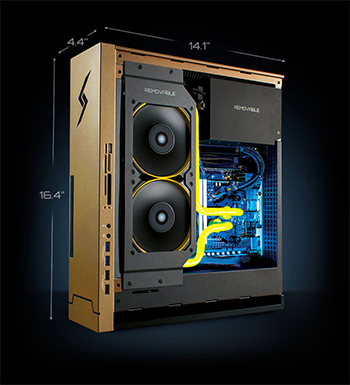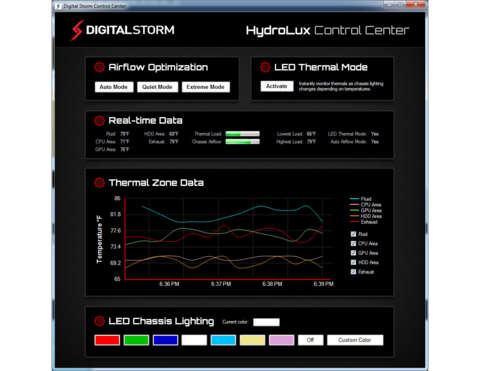Building your own PC is a rewarding experience, but some people have neither the knowledge, nor the desire to tackle such a project. These people aren't wooed by the notion of getting their hands dirty and would rather skip to the finish line and pay a handsome sum for a pre-built gaming PC. These are the customers that Digital Storm's targeting with its Bolt II gaming PC. It's good looking, small--svelte enough to fit into a home theater arrangement--and filled to the brim with desirable hardware.
As you might expect, such a machine doesn't come cheap--the unit we're testing costs $3,323. Perhaps unsurprisingly, you could theoretically save around $1,000 if you purchased the equivalent parts and assembled them yourself, but the sum of the Bolt II's hardware doesn't account for Digital Storm's system building prowess, the Bolt II's custom case, and a generous warranty (one year parts replacement and three years labor), which are valuable in their own right. No matter how you slice it, the Bolt II is a boutique PC for people with boutique tastes.

Digital Storm Bolt II
GPU: Nvidia GTX 780 Ti 3GB GDDR5
CPU: Intel Core i7-4790K (4.0 Ghz)
RAM: 16GB DDR3 RAM Corsair Vengeance 1866 Mhz
SSD: 840 Evo 500GB SSD
HDD: 2 TB Western Digital Black HDD 7200 RPM
MB: Asus Z97I-Plus Motherboard
OS: Windows 8.1
Extras: MMC Reader, BD/DVD-R Drive, Custom Watercooling w/ Hydrolux thermal controls
Case: Custom Digital Storm case
Warranty: 3 years labor, 1 year parts
Total Cost: $3,323
Before diving into the Bolt II from a technical perspective, it's worth regarding how slim and good looking it is. It's 4.4" wide, 16.4" tall, and 14.1" deep, and it looks clean in spite of the fact that it's spotted with ports and vents. The unit that Digital Storm sent for this review is coated in a bronze finish that may be unorthodox, but it looks like a practical and classy piece of equipment rather than kitschy piece of gamer kit. Though most people will keep it upright, it's worth pointing out that Digital Storm installed removable risers in case you wanted to lay it flat and incorporate it into a home theater setup. Though you may also think it'd be fit to sit underneath a monitor, you're more than likely going to block the vents next to the water cooling radiator and potentially scratch up the plastic window.
System Build
In the eyes of fashionable system-builders that live on the cutting edge of desktop tech, the Bolt II's hardware may look marginally outdated, but even without a Nvidia GTX 980 GPU, a Haswell-E Core-i7 CPU, or DDR4 RAM, it's still capable of chewing through games and spitting out satisfying frame rates. Not only that, but Digital Storm's cooling solution for the Bolt II keeps it cool and quiet at all times thanks to a massive 240mm radiator connected to the CPU. To fit everything into the small case, Digital Storm had to route the GPU to the underside of the motherboard using a PCI-E daughter card, but this arrangement puts the card's intake fan right in front of a vent on the side panel, meaning that the card isn't pulling in warm ambient air from inside the case. At idle, the Bolt II's fans are barely audible from a foot away, and at full blast, it's merely a hair louder.
Cooling

Digital Storm packed a HydroLux cooling system card into the Bolt II to give you control over fans and access to temperature data from the CPU, GPU, HDD, exhaust, and cooling fluid sensors. You interface with the card using the HydroLux Control Center application, and if you're trying to overclock the Bolt II in any way, it's a great resource to have, but it could benefit from being more flexible. It's immediately confusing when you can only view temperature readouts in fahrenheit, for example. While it's the standard unit for temperature in North America, celsius is favored by the PC community and universally referenced in overclocking guides and enthusiast forums. To the best of my ability, I wasn't able to find a way to swap fahrenheit for celsius within the control center. In fact, there are no configuration options for the Control Center's interface. It allows you to swap between different fan-speed profiles and tinker with LED lighting, but the interface itself is static. As useful as it is, it would greatly benefit from customization options.
| Bolt II - Quiet Fan Mode | Idle | Load |
|---|---|---|
| Haswell Core i7 4970k CPU | 32 ° C | 40 ° C |
| Nvidia GTX 780 Ti GPU | 26 ° C | 33 ° C |
| Bolt II - Extreme Fan Mode | Idle | Load |
| Haswell Core i7 4970k CPU | 31 ° C | 36 ° C |
| Nvidia GTX 780 Ti GPU | 25° C | 29 ° C |
To get a handle on the system's cooling capabilities, we recorded temperature readings from the CPU and GPU while the computer was idling and under full load. To push the CPU, we used George Woltman's Prime 95, and for the GPU, Metro: Last Light's benchmark at full blast on 1440p. Considering that the ceiling for safe temperatures on a Haswell Core i7 CPU is 67 degrees celsius and 95 degrees celsius for the GTX 780 Ti GPU, the Bolt II has great overclocking potential.
Benchmarks
| Benchmark | 1080p, Max Settings | 1440p, Max Settings |
|---|---|---|
| Tomb Raider | 48 FPS | 30 FPS |
| Bioshock Infinite | 120 FPS | 79 FPS |
| Metro: Last Light | 46 FPS | 30 FPS |
| Crysis 3 | 51 FPS | 33 FPS |
| Battlefield 4 | 88 FPS | 55 FPS |
| Unigine Heaven 4.0 | 57 FPS | 36 FPS |
The Bolt II clearly has the power to play the most demanding PC games at good frame rates, and even when playing at 1440p with max settings, everything remains playable. Still, when paying more than $3,000 for a PC, the fact that you can't hit the magical 60 FPS benchmark in some games set to max at 1080p is no doubt a little disappointing. Sure, a tweak to demanding post-processing and antialiasing settings will get you there, but at this price point, it's a little disappointing that it's not better across the board. Beyond taking on a more powerful graphics card and thus increasing the system's final cost, there's not much else you can do beyond overclocking for a slight boost in frame rates.
Final Thoughts
There are so many reasons to appreciate the Bolt II. From the petite chassis to the powerful hardware, it's a fantastic specimen. Be that as it may, it's hard to ignore the price tag. Granted, the Bolt II we have is fitted with extra goodies including a BD-ROM drive and high-capacity boot and storage drives. Trim those down, and you can save about $500. Still, no matter how you spin it, the Bolt II is a luxury item, and thus the value proposition is distorted if you're only considering the raw power inside. When buying a luxury gaming PC like the Bolt II, you're paying for the parts, but also the system builder's handiwork. In this case, that includes the custom chassis, cooling system, warranty, and highly-skilled system configuration and cable management. You're also paying for convenience. If money is a concern, you may want to build your own PC or go with something that's less flashy, but if you're looking for a gaming PC that's good looking, powerful, and you aren't worried about a budget, the Bolt II is a great option.
